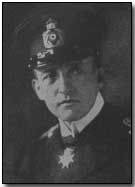Encyclopedia - U-20 and the Lusitania
 Built in 1913 the diesel
generated U-20 submarine gained notoriety during the First World War for its
sinking of
the giant Lusitania cruise vessel.
Built in 1913 the diesel
generated U-20 submarine gained notoriety during the First World War for its
sinking of
the giant Lusitania cruise vessel.
Forming part of the High Seas Fleet the U-20 was despatched on commerce raiding missions in 1915. On the morning of 7 May 1915, off the coast of Ireland its Captain, Walter Schweiger, fired a single G-type torpedo - his last available - at the RMS Lusitania at 1.35, striking forward of the bridge on its starboard side.
Schweiger was unsure how much damage he would inflict; he was certainly unaware that it would succeed in sinking the giant Cunard-owned liner. That it would sink within 18 minutes generated a storm of protest from outraged neutral countries: the Lusitania had carried some 124 U.S. citizens among a total of 1,198 casualties.
The German government, initially delighted with its success, subsequently apologised in February 1916 to the U.S. government for the loss of its citizens and offered to pay reparations, chiefly from a desire to maintain neutral relations with the U.S. The Germans nevertheless claimed that the Lusitania was carrying munitions and therefore a legitimate wartime target.
The British government denied the charge (still debated today although probably correct) and in turn fanned the flames by suggesting that the U-20 had fired not once but twice into the Lusitania, reporting that two separate explosions were clearly witnessed by survivors. The Germans angrily refuted the British claim (correctly; only one torpedo was fired).
Schweiger and the 32-man crew of U-20 were no stranger to controversy. On 1 February 1915, some three months prior to the Lusitania sinking, the U-20 fired at a hospital ship in the English Channel, again heralding a storm of criticism.
The U-20 itself was grounded west of Jutland in November 1916 and was obliged to request assistance. Given the U-boat's reputation the call was answered by the German provision not only of a salvage ship but by an accompanying warship and two battleships.
Nevertheless the U-20 could not be re-floated and was destroyed as a preventative measure. The British however managed to intercept German radio communications with the consequence that the submarine J-1 arrived in time to torpedo (but not sink) both battleships.
Memoirs and Diaries: A Runner's Story
The Austro-Hungarian declaration of war was the first ever delivered by telegram.
- Did you know?
